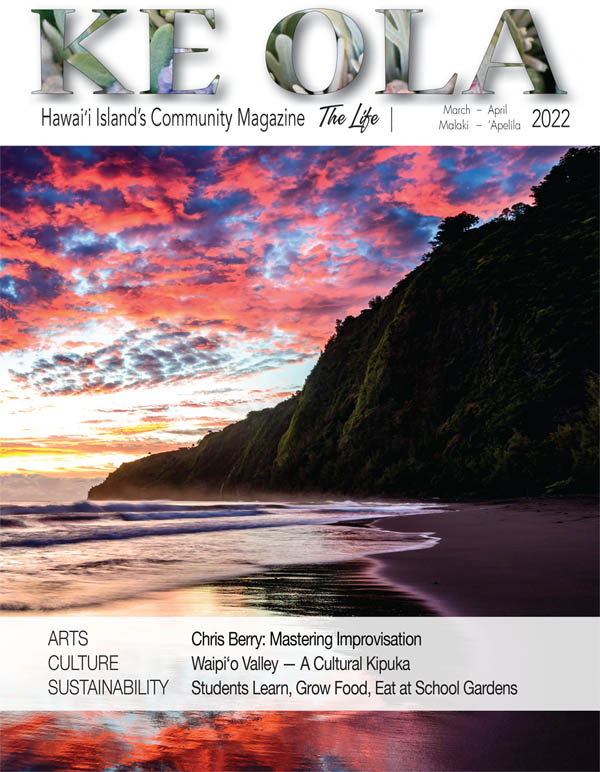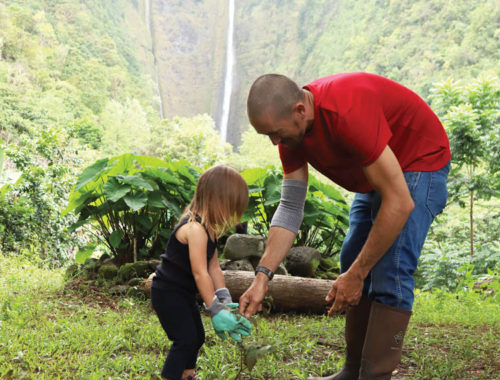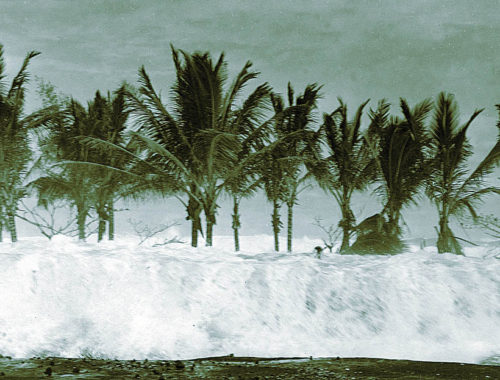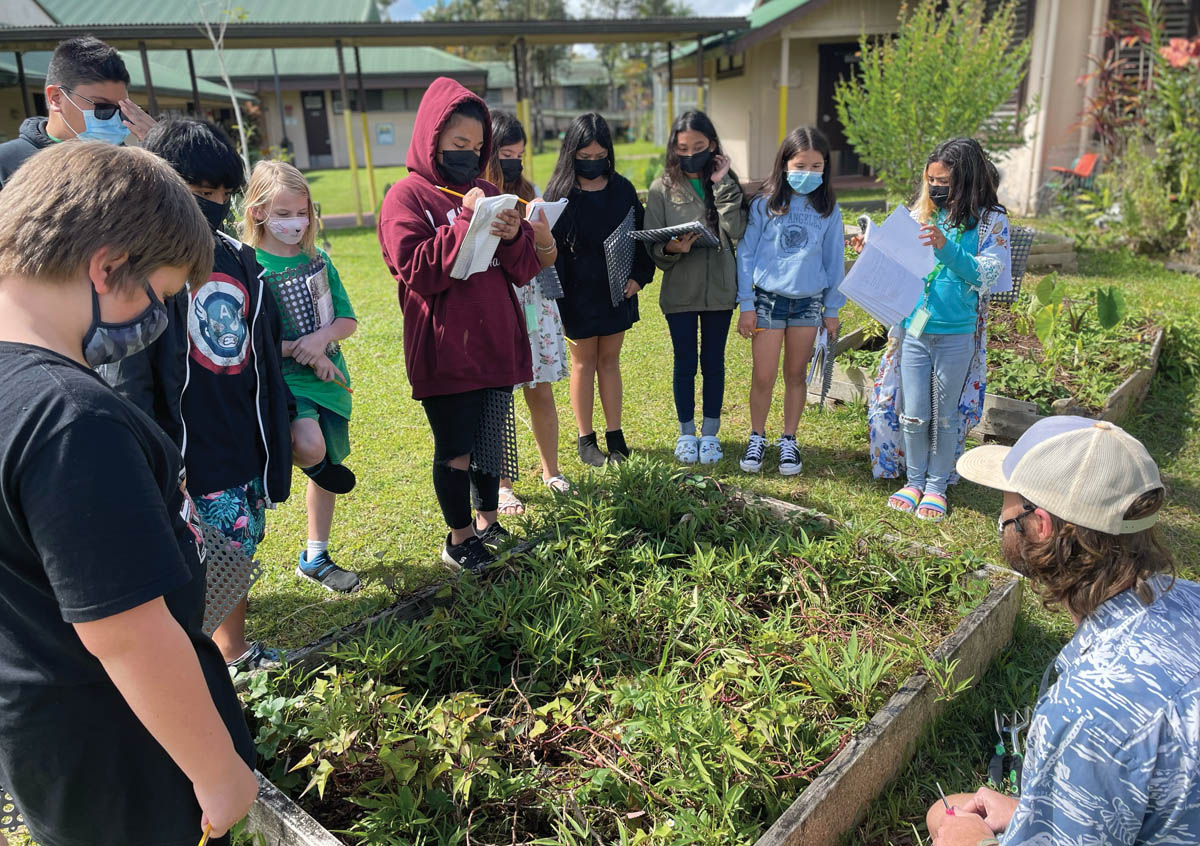
Students Learn, Grow Food, Eat at School Culinary Gardens

By Fern Gavelek
Itʻs all about “connecting the dots to textbooks while making learning delicious.”
That’s how Patti Cook, community development director of Waimea Middle Public Conversion Charter School, describes the Māla‘ai Culinary Garden. Started in 2003 through a community effort, the Waimea school garden is the poster child for the Hawai‘i Island School Garden Network (HISGN) and their Kū ‘Āina Pā School Garden Teacher Training.
At more than 60 schools across Hawai‘i Island, school gardens are engaging students in learning math, science, health, reading, writing, and teamwork with guidance from the Hawai‘i School Garden Curriculum Map (HSGCM). Kū ‘Āina Pā has graduated more than 200 K–8 educators who have pioneered garden-based learning in Hawai‘iʻs statewide schools.
Thatʻs right—the success of Māla‘ai helped inspire schools across the state to implement culinary gardens into their curriculums. There are five island-level school garden networks in Hawai‘i and all are members of the larger Hawai‘i Farm to School Hui that provides political advocacy and resources.
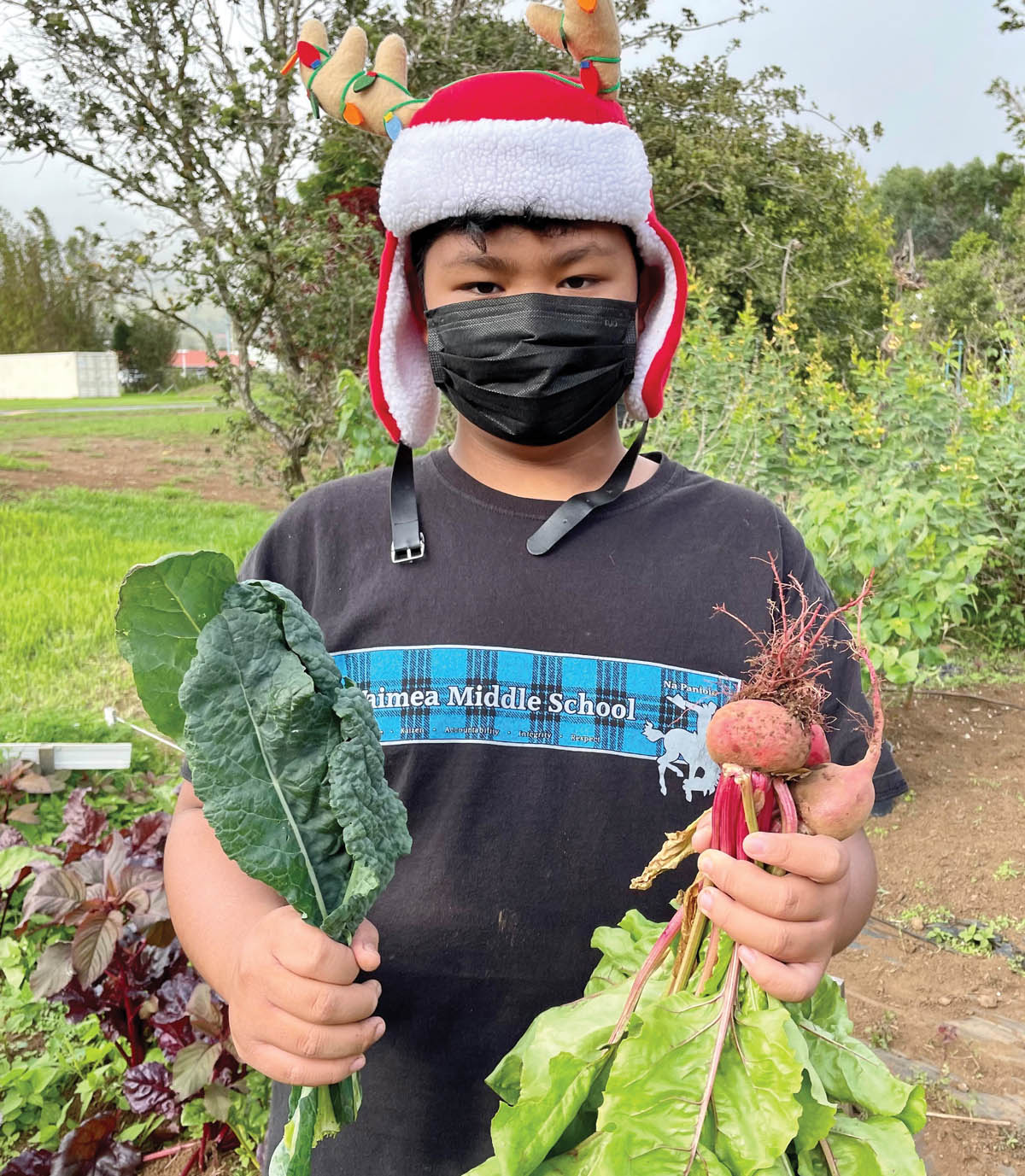
It Takes a Village to Start a School Garden
Māla‘ai became a model garden through the dedicated efforts of school garden visionary Amanda Rieux and a group of community stakeholders. Initiating the garden’s formation was Waimea physician Michelle Suber, who was concerned with diet-based illness among her patients. Dr. Suber invited Amanda, a school garden educator at Alice Waters’s Edible School Yard at Martin Luther King Middle School in Berkeley, California to come to Waimea and join a workshop with interested community members.
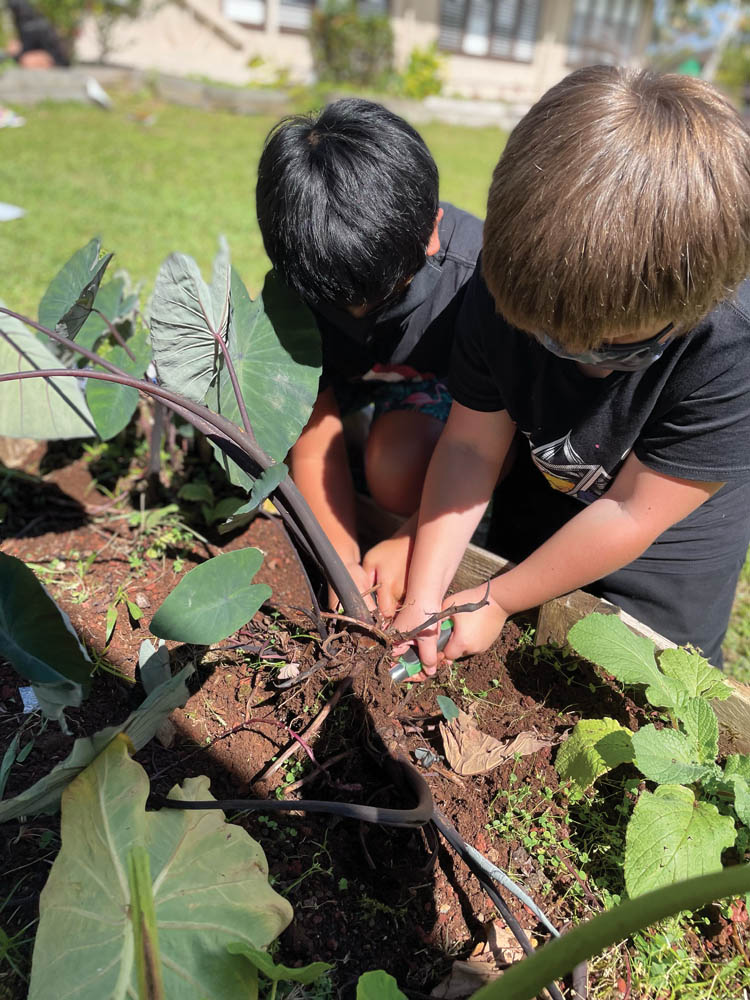
This enthusiastic group worked with Waimea Middle School on the garden’s possibilities. A board of directors and nonprofit formed, and Amanda became the school’s garden leader in 2005, subsequently laying the foundation for Māla‘ai.
The way Māla‘ai works is somewhat modeled after Edible School Yard, according to Amanda, who eventually served as the garden’s executive director while also involved with HISGN and HSGCM, before stepping down in 2021.
While classroom teachers accompany students into the school garden, Amanda emphasizes the garden leader does the garden teaching. “Learning has a physical manifestation in the school garden—you can see it, you can taste it—so it’s really tangible and that’s important.” Amanda also adds the value she learned at the Edible School Yard of “using the garden to engage all of the senses of the children in their learning: seeing and hearing, but also touching, smelling, and very importantly, tasting” has been key to Māla‘ai’s success.
Māla‘ai: An Act of Love with the Best of Intentions
“My experience at Edible School taught me what we’re doing is an act of love for the children and the land, and with that thought, that’s the way we prioritize our teaching and facilitate the program,” Amanda details. “That love is a real and tangible value that’s benefited Māla‘ai as evidenced by the program’s wonderful allies.”
In addition, Amanda emphazies, “the culture of this place, of Hawai‘i” also plays a critical role in all aspects of the garden. “The work is so gratifying—it’s an act of service and love that nurtures the children, honors the culture, creates food, and is done with the best of intentions.” She adds Māla‘ai is a collaborative and supportive community effort.
The help of volunteers is critical at Māla‘ai as it enables all of the school’s students to participate. Culinarian Sandy Barr Rivera has been woven in and out of the program as a volunteer for almost 20 years. While she’s “shown up for workdays and cleaned the tool shed or pruned fruit trees,” the retired chef has also done culinary class presentations and cooked food for summer teacher training sessions.
“Volunteers tell us they have amazing conversations with students when they are on their knees digging in the dirt,” shares Patti. “They get as much out of it as the kids do.”
To have the resources needed for the one-acre Waimea school garden—which grows a bevy of veggies, fruits, and flowers—Māla‘ai does its own fundraising and grant writing. New garden Executive Director Zoe Kosmas is at the helm of that effort while bringing new energy to the garden and HISGN.
“Māla‘ai basically provides food for the students to learn to prepare and enjoy,” says Zoe. “The idea is they grow, prepare, and present it, and agree to taste everything once.”
Holly Sargeant-Green, Māla‘ai garden leader involved with the program since 2006, sums up the gardenʻs benefit, “More than ever during these challenging times, it’s important for our children to have the opportunity to be outside, socializing, and learning about the ‘āina. Being in the garden gives students a better understanding of themselves and their place in the community.”
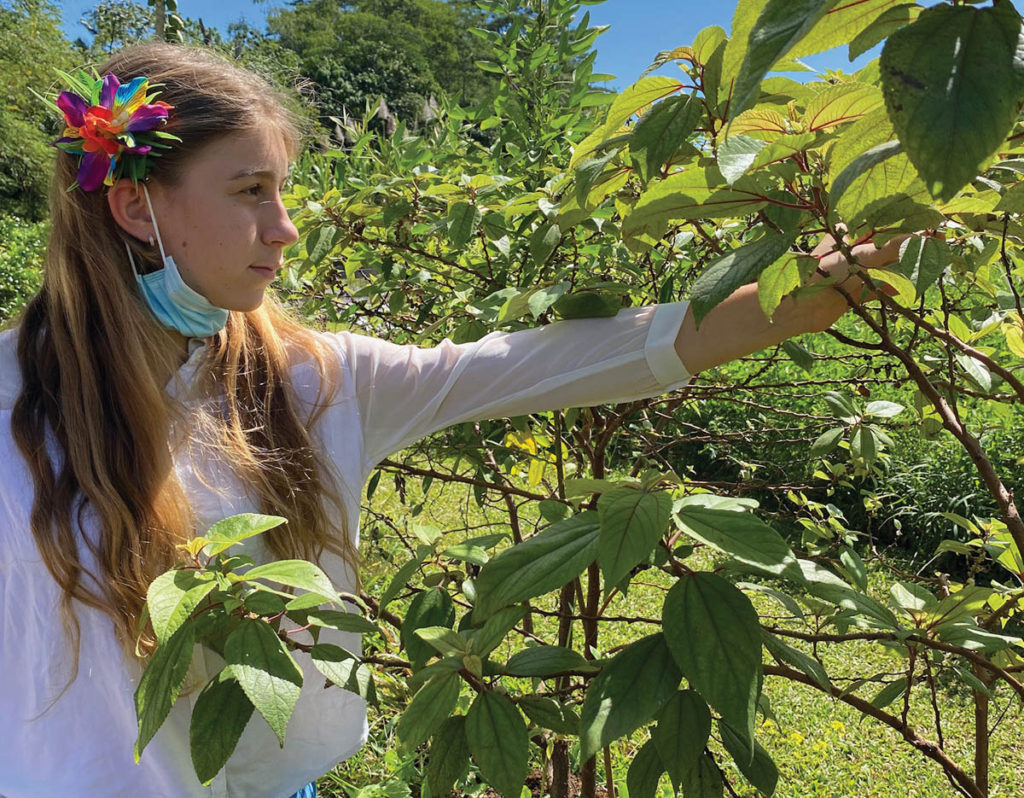
Hawai‘i School Garden Curriculum Map
Following the HSG Curriculum Map for grades K–8, instruction at Hawai‘i school gardens involves four themes with a variety of different topics. Themes are A Sense of Place: Sustainable Living is Rooted in a Deep Knowlege of Place and Self, The Living Soil–The Living Plant: We Are All Interconnected and Related, Nourishment: Feeding Our Mind and Body with What It Needs to Stay Healthy and Flourish, and Natureʼs Design: Systems, Cycles, Pattern, Relationships, and Adaptations in the Garden System.
For example, with Sense of Place, the scope of study is weather and seasons for that specific location—topics covered include Hawaiian names and patterns for local weather, the lunar cycle, local legends and stories, plus the local ag industry. In this sequence, garden students in grades K–2 could create a daily weather journal and observe and record weather by reading a thermometer and rain gauge. Older students could design and conduct an experiment using data from local weather patterns and events.
Garden to Grinds in Pāhoa
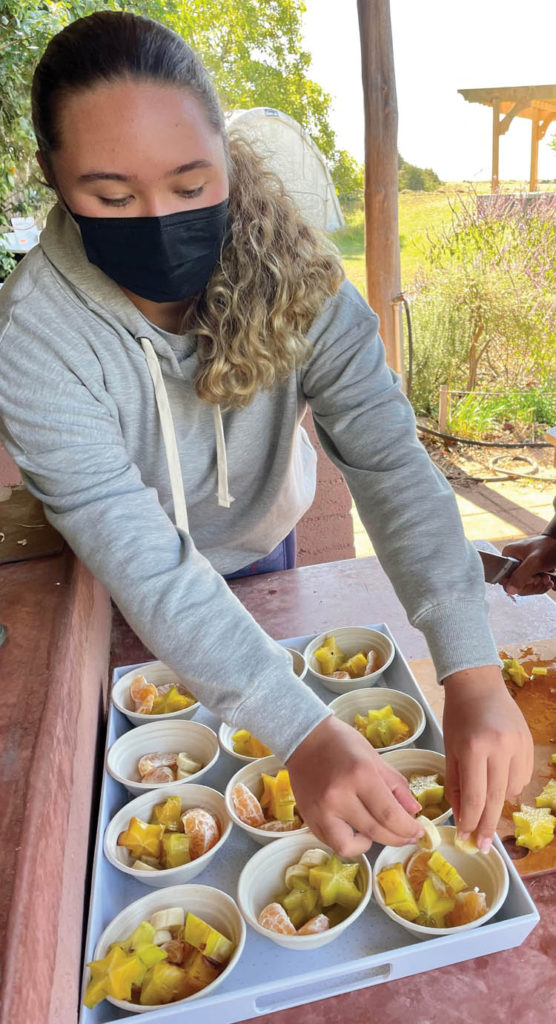
School gardening is an elective for students in grades 7–12 at Hawaii Academy of Arts & Science Public Charter School in Pāhoa. Wendy Baker has been at the helm of the school’s Gardens to Grinds program for 10 years, teaching about 40 kids per year. “We compete with skating, surfing, and band, but gardening is becoming more popular,” she grins.
When Wendy came to the progam, it had an Iron Chef competition with students first deciding on a recipe and then growing what was needed to furnish ingredients.
“Now the garden is a learning classroom where we grow what works best for our environment,” she notes. “We try to grow what kids want and sometimes it works or not—great lesson.”
Similar to Māla‘ai, students follow a protocol when entering the garden. They recite a chant specially written by Kumu Keala Ching, followed by two minutes of observation. Wendy says the lessons follow the HSG Curriculum Map. The garden is about a half-acre in size and comprised of 10 25-foot-long mounded beds. They also tend an orchard with 30 diverse fruit trees.
“Garden diversity is important,” stresses Wendy. “Kids learn every fruit and veggie contributes taste and nutrition, resulting in a better diet and health.”
Garden to Grinds also has a garden growing native plants for the school’s Hawaiian studies pathway, a sheltered classroom, tool shed, covered greenhouse, and food processing area. As a senior project, school alum Alex Dodge organized the creation of the food processing building. The screened-in covered structure was financed by the Pāhoa nonprofit Arts & Sciences Center. Wendy got a grant to outfit the kitchen with a sink, stove, shelves, and cookware. The kitchen is used to make snacks from the garden’s bounty.
“Alex’s brother, Michael, was in my first class and he grew broccoli that never crowned,” Wendy recalls. “He used the leaves anyway for his Iron Chef recipe and proudly took the experience home to his family. That participation inspired Alex to design our kitchen.”
Mountain View Māla
Māla means garden in Hawaiian and 500 students at Mountain View Elementary School participate annually in the school’s veggie and fruit growing. Overseeing the program is Jaime Lewis of Kea‘au while Matt Mittermayer—originally of the national nonprofit FoodCorps—serves as the garden teacher.
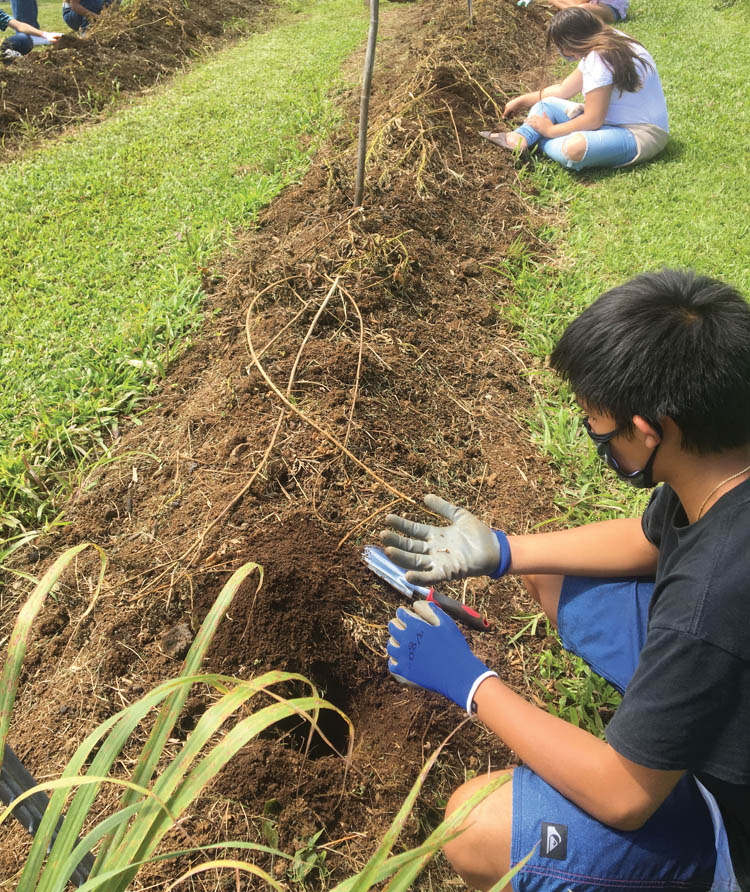
“Our school garden is a resource class and each student attends the class once weekly,” explains Jaime, who doubles as an honors instructor for grades three to five. Jaime coordinates all the garden activities, including staff Blue Zones functions, volunteer garden workdays, and lesson plans.
“Our future goal is not for gardening to be a resource course, but for general ed teachers to do their teaching in the garden,” she explains.
Jaime is also working with a fellow school instructor on piloting a Garden Pacing Guide that takes Next Generation Science Standards and applies them to using the garden as a teaching tool. Jaime accesses the HSG Curriculum Map to help with the guide, which is “customized for our school.”
Because of recent drainage work at the 10-acre campus, the main learning garden was temporarily moved to the existing staff garden location. Students also have access to two 20-square-foot garden boxes placed near classrooms for each grade level. A lei garden provides native flowers and orchids.
“We will put together a committee to plan a whole new learning garden and orchard,” shares Jaime. “We’d like to attain grant funding to build a garden hale.”
Due to Covid-19, the garden program hasn’t included food prep with students. Garden bounty is distributed for home use or sold to school staff as a fundraiser.
“In the past, we used our garden kalo [taro] at the fifth grade banquet,” recalls Jaime. “Kids got to plant, grow, harvest, and eat the kalo all in one school year. It connected them to this place, our host culture, and the process that feeds them.” ❖
For info: malaai.org, hiphi.org/farmtoschool/
